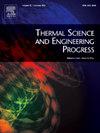Application of environmental thermal energy simulation and audio image processing in film and television animation sound design
IF 5.1
3区 工程技术
Q2 ENERGY & FUELS
引用次数: 0
Abstract
In modern film and television animation production, sound design is a key link to create a sense of realism and immersion. With the development of technology, traditional sound design methods have been unable to fully meet the growing needs of audiences. In this paper, the environmental thermal energy simulation technology is combined with audio image processing technology, and the thermal energy model is established by collecting temperature data in different environments. Then the thermal energy simulation software is used to simulate the influence of temperature change on sound propagation, including attenuation, reflection and refraction of sound. Simulation results are applied to sound design to create sound effects that match the characteristics of a particular environment. By analyzing the visual elements in the animation, the image features related to sound are extracted. Using the audio image processing algorithm, these features are matched and synchronized with the sound signal to ensure the perfect combination of sound effect and picture. Machine learning technology is also applied to train a large amount of audio and video data to improve the accuracy and efficiency of sound and image synchronization processing. The results show that the sound effect is more realistic: the environmental thermal energy simulation technology can accurately simulate the propagation characteristics of sound in different temperature environments, making the sound effect more real and dynamic. By automatically analyzing and processing large amounts of audio and video data, sound designers can quickly find the best sound effects, shorten design cycles and reduce production costs.
求助全文
约1分钟内获得全文
求助全文
来源期刊

Thermal Science and Engineering Progress
Chemical Engineering-Fluid Flow and Transfer Processes
CiteScore
7.20
自引率
10.40%
发文量
327
审稿时长
41 days
期刊介绍:
Thermal Science and Engineering Progress (TSEP) publishes original, high-quality research articles that span activities ranging from fundamental scientific research and discussion of the more controversial thermodynamic theories, to developments in thermal engineering that are in many instances examples of the way scientists and engineers are addressing the challenges facing a growing population – smart cities and global warming – maximising thermodynamic efficiencies and minimising all heat losses. It is intended that these will be of current relevance and interest to industry, academia and other practitioners. It is evident that many specialised journals in thermal and, to some extent, in fluid disciplines tend to focus on topics that can be classified as fundamental in nature, or are ‘applied’ and near-market. Thermal Science and Engineering Progress will bridge the gap between these two areas, allowing authors to make an easy choice, should they or a journal editor feel that their papers are ‘out of scope’ when considering other journals. The range of topics covered by Thermal Science and Engineering Progress addresses the rapid rate of development being made in thermal transfer processes as they affect traditional fields, and important growth in the topical research areas of aerospace, thermal biological and medical systems, electronics and nano-technologies, renewable energy systems, food production (including agriculture), and the need to minimise man-made thermal impacts on climate change. Review articles on appropriate topics for TSEP are encouraged, although until TSEP is fully established, these will be limited in number. Before submitting such articles, please contact one of the Editors, or a member of the Editorial Advisory Board with an outline of your proposal and your expertise in the area of your review.
 求助内容:
求助内容: 应助结果提醒方式:
应助结果提醒方式:


